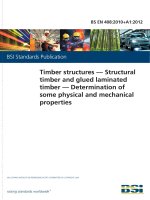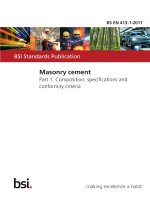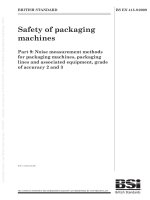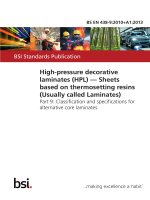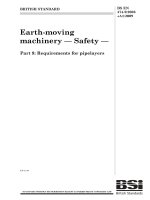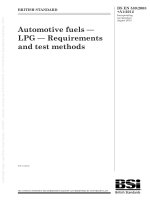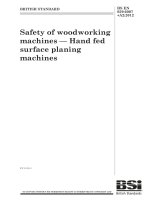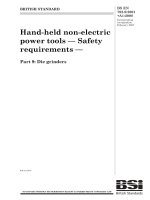Bsi bs en 62047 9 2011 (2012)
Bạn đang xem bản rút gọn của tài liệu. Xem và tải ngay bản đầy đủ của tài liệu tại đây (1.38 MB, 30 trang )
BS EN 62047-9:2011
Incorporating corrigendum March 2012
BSI Standards Publication
Semiconductor devices —
Micro-electromechanical
devices
Part 9: Wafer to wafer bonding strength
measurement for MEMS
BRITISH STANDARD
BS EN 62047-9:2011
BS EN 62047-9:2011
National foreword
BRITISH STANDARD
This British Standard is the UK implementation
of EN
EN 62047-9:2011.
62047-9:2011. ItItisis
implementation of
identical
identical to IEC 62047-9:2011,
62047-9:2011.incorporating corrigendum March 2012.
National foreword
The UK
startparticipation
and finish ofintext
introduced or
altered
by corrigendum
indicated
its preparation
was
entrusted
to Technical is
Committee
in
the
text
by
tags.
Text
altered
by
IEC
corrigendum
March
2012
is
indicated
This British
Standard is the UK implementation of EN 62047-9:2011. It is
EPL/47,
Semiconductors.
in
the text
.
identical
toby
IEC
62047-9:2011.
A list of organizations represented on this committee can be obtained on
The
UK participation
in its preparation was entrusted to Technical Committee
request
to its secretary.
EPL/47, Semiconductors.
This publication does not purport to include all the necessary provisions of a
A
list of organizations
represented
oncorrect
this committee
can be obtained on
contract.
Users are responsible
for its
application.
request to its secretary.
© BSI 2011
This publication does not purport to include all the necessary provisions of a
ISBN 978 0 580 60631 1
contract. Users are responsible for its correct application.
ICS 31.080.99
© The
BSI 2011
British Standards Institution 2013.
Published by BSI Standards Limited 2013
ISBN 978 0 580 60631 1
Compliance
a British
Standard cannot confer immunity from
ISBN31.080.99
978 0 580with
78793
5
ICS
legal obligations.
ICS 31.080.99
Compliance with a British Standard cannot confer immunity from
This British Standard was published under the authority of the Standards
legal
obligations.
Compliance
with a British Standard cannot confer immunity from
Policy and Strategy Committee on 30 September 2011.
legal obligations.
This British
British Standard
Standard was
was published
of the
the Standards
Standards
This
published under
under the
the authority
authority of
Amendments
issued
since publication
Policy
and
Strategy
Committee
on
30
September
2011.
Policy and Strategy Committee on 30 September 2011.
Amd. No.
Date
Text affected
Amendments/corrigenda issued since publication
Amendments
issued Text
since
publication
Date
affected
Amd.
No. 2013
31 January
Date
Text
Implementation of
IECaffected
corrigendum March 2012
BS EN 62047-9:2011
EN 62047-9
EUROPEAN STANDARD
NORME EUROPÉENNE
EUROPÄISCHE NORM
August 2011
ICS 31.080.99
English version
Semiconductor devices Micro-electromechanical devices Part 9: Wafer to wafer bonding strength measurement for MEMS
(IEC 62047-9:2011)
Dispositifs à semiconducteurs Dispositifs microélectromécaniques Partie 9: Mesure de la résistance de
collage de deux plaquettes pour les
MEMS
(CEI 62047-9:2011)
Halbleiterbauelemente Bauelemente der Mikrosystemtechnik Teil 9: Prüfverfahren zur Festigkeit von
Full-Wafer-Bondverbindungen in der
Mikrosystemtechnik (MEMS)
(IEC 62047-9:2011)
This European Standard was approved by CENELEC on 2011-08-17. CENELEC members are bound to comply
with the CEN/CENELEC Internal Regulations which stipulate the conditions for giving this European Standard
the status of a national standard without any alteration.
Up-to-date lists and bibliographical references concerning such national standards may be obtained on
application to the Central Secretariat or to any CENELEC member.
This European Standard exists in three official versions (English, French, German). A version in any other
language made by translation under the responsibility of a CENELEC member into its own language and notified
to the Central Secretariat has the same status as the official versions.
CENELEC members are the national electrotechnical committees of Austria, Belgium, Bulgaria, Croatia, Cyprus,
the Czech Republic, Denmark, Estonia, Finland, France, Germany, Greece, Hungary, Iceland, Ireland, Italy,
Latvia, Lithuania, Luxembourg, Malta, the Netherlands, Norway, Poland, Portugal, Romania, Slovakia, Slovenia,
Spain, Sweden, Switzerland and the United Kingdom.
CENELEC
European Committee for Electrotechnical Standardization
Comité Européen de Normalisation Electrotechnique
Europäisches Komitee für Elektrotechnische Normung
Management Centre: Avenue Marnix 17, B - 1000 Brussels
© 2011 CENELEC -
All rights of exploitation in any form and by any means reserved worldwide for CENELEC members.
Ref. No. EN 62047-9:2011 E
BS EN 62047-9:2011
EN 62047-9:2011
-2-
Foreword
The text of document 47F/82/FDIS, future edition 1 of IEC 62047-9, prepared by SC 47F, Microelectromechanical systems, of IEC TC 47, Semiconductor devices, was submitted to the IEC-CENELEC
parallel vote and was approved by CENELEC as EN 62047-9 on 2011-08-17.
Attention is drawn to the possibility that some of the elements of this document may be the subject of
patent rights. CEN and CENELEC shall not be held responsible for identifying any or all such patent
rights.
The following dates were fixed:
– latest date by which the EN has to be implemented
at national level by publication of an identical
national standard or by endorsement
(dop)
2012-05-17
– latest date by which the national standards conflicting
with the EN have to be withdrawn
(dow)
2014-08-17
Annex ZA has been added by CENELEC.
__________
Endorsement notice
The text of the International Standard IEC 62047-9:2011 was approved by CENELEC as a European
Standard without any modification.
In the official version, for Bibliography, the following notes have to be added for the standards indicated:
IEC 62047-2
NOTE Harmonized as EN 62047-2.
IEC 62047-4
NOTE Harmonized as EN 62047-4.
__________
BS EN 62047-9:2011
EN 62047-9:2011
-3-
Annex ZA
(normative)
Normative references to international publications
with their corresponding European publications
The following referenced documents are indispensable for the application of this document. For dated
references, only the edition cited applies. For undated references, the latest edition of the referenced
document (including any amendments) applies.
NOTE When an international publication has been modified by common modifications, indicated by (mod), the relevant EN/HD
applies.
Publication
Year
Title
EN/HD
Year
IEC 60749-19
-
Semiconductor devices - Mechanical and
climatic test methods Part 19: Die shear strength
EN 60749-19
-
ISO 6892-1
2009
Metallic materials - Tensile testing Part 1: Method of test at room temperature
EN ISO 6892-1
2009
ASTM E399-06e2
2008
Standard Test Method for Linear-Elastic
Plane-Strain Fracture Toughness K Ic of
Metallic Materials
-
-
–2–
BS EN 62047-9:2011
62047-9 IEC:2011
CONTENTS
1
Scope ............................................................................................................................... 6
2
Normative references ....................................................................................................... 6
3
Measurement methods ..................................................................................................... 6
3.1
3.2
3.3
3.4
3.5
3.6
3.7
3.8
Annex A
General ................................................................................................................... 6
Visual test ............................................................................................................... 6
3.2.1 Types of visual test...................................................................................... 6
3.2.2 Equipment ................................................................................................... 7
3.2.3 Procedure .................................................................................................... 7
3.2.4 Expression of results ................................................................................... 7
Pull test ................................................................................................................... 7
3.3.1 General ....................................................................................................... 7
3.3.2 Equipment ................................................................................................... 8
3.3.3 Procedure .................................................................................................... 8
3.3.4 Expression of results ................................................................................... 9
Double cantilever beam test using blade ................................................................. 9
3.4.1 General ....................................................................................................... 9
3.4.2 Equipment ................................................................................................. 11
3.4.3 Procedure .................................................................................................. 11
3.4.4 Expression of results ................................................................................. 11
Electrostatic test.................................................................................................... 12
3.5.1 General ..................................................................................................... 12
3.5.2 Equipment ................................................................................................. 13
3.5.3 Procedure .................................................................................................. 13
3.5.4 Expression of results ................................................................................. 14
Blister test ............................................................................................................. 14
3.6.1 General ..................................................................................................... 14
3.6.2 Preparation of the specimens .................................................................... 15
3.6.3 Test apparatus and testing method ............................................................ 15
3.6.4 Report ....................................................................................................... 16
Three-point bending test........................................................................................ 16
3.7.1 General ..................................................................................................... 16
3.7.2 Preparation of the specimens .................................................................... 17
3.7.3 Test apparatus and testing method ............................................................ 18
3.7.4 Report ....................................................................................................... 19
Die shear test ........................................................................................................ 19
3.8.1 General ..................................................................................................... 19
3.8.2 Preparation of the specimens .................................................................... 20
3.8.3 Test apparatus .......................................................................................... 21
3.8.4 Test method .............................................................................................. 21
3.8.5 Shear bonding strength ............................................................................. 22
3.8.6 Report ....................................................................................................... 22
(informative) Example of bonding force .................................................................. 23
Annex B (informative) An example of the fabrication process for three-point bending
specimens ............................................................................................................................ 24
Bibliography .......................................................................................................................... 25
BS EN 62047-9:2011
62047-9 IEC:2011
–3–
Figure 1 – Bonding strength measurement – pull test .............................................................. 8
Figure 2 – Bonding strength measurement – double cantilever beam (DCB) test
specimen using blade ........................................................................................................... 10
Figure 3 – Bonding strength measurement – electrostatic test ............................................. 13
Figure 4 – A specimen for blister test .................................................................................... 15
Figure 5 – Three-point bending specimen and loading method .............................................. 17
Figure 6 – Specimen geometry of three-point bending specimen ........................................... 18
Figure 7 – Die shear testing set-up ....................................................................................... 19
Figure 8 – Size requirement of control tool and specimen ..................................................... 20
Figure 9 – Example of bonded region in test piece ................................................................ 20
Figure 10 – Setting of contact tool ........................................................................................ 22
Figure A.1 – An example of bonding force or load measurement with time at constant
rate of upper fixture moving .................................................................................................. 23
Figure B.1 – An example of specimen preparation for three-point bending test ..................... 24
Table 1 – Example of visual test ............................................................................................. 7
Table 2 − Example of pull test ................................................................................................. 9
Table 3 – Example of Double Cantilever Beam test using blade ............................................ 12
Table 4 – Example of electrostatic test ................................................................................. 14
–6–
BS EN 62047-9:2011
62047-9 IEC:2011
SEMICONDUCTOR DEVICES –
MICRO-ELECTROMECHANICAL DEVICES –
Part 9: Wafer to wafer bonding strength measurement for MEMS
1
Scope
This standard describes bonding strength measurement method of wafer to wafer bonding,
type of bonding process such as silicon to silicon fusion bonding, silicon to glass anodic
bonding, etc., and applicable structure size during MEMS processing/assembly. The
applicable wafer thickness is in the range of 10 µm to several millimeters.
2
Normative references
The following referenced documents are indispensable for the application of this document.
For dated references, only the edition cited applies. For undated references, the latest edition
of the referenced document (including any amendments) applies.
IEC 60749-19, Semiconductor devices – Mechanical and climatic test methods – Part 19: Die
shear strength
ISO 6892-1: 2009, Metallic materials – Tensile testing – Part1: Method of test at room
temperature
ASTM E399-06e2: 2008, Standard Test Method for Linear-Elastic Plane-Strain Fracture
Toughness K Ic of Metallic Materials
3
Measurement methods
3.1
General
There are different ways to measure bonding strength such as visual test, pull test, double
cantilever beam test using blade, electrostatic test, blister test, three-point bend test, and die
shear test.
3.2
3.2.1
Visual test
Types of visual test
From colour change of silicon substrate and surface of glass, this method tells you only a
general information like whether the material is bonded or not. The visual test shall be
performed to confirm whether substantial other bonding tests are required, and/or to identify
the area that the bonding tests shall be conducted.
Optical microscope shall be used to evaluate the bonding interface of glass to silicon and
glass to glass.
An infrared (IR) camera shall be used to observe voids existing in the bonding interface of
silicon to silicon
NOTE
Visual test is a simple qualitative test method.
BS EN 62047-9:2011
62047-9 IEC:2011
3.2.2
–7–
Equipment
One or a few equipments of optical microscope, scanning acoustic microscope, scanning
electron microscope (SEM), transmission electron microscope (TEM), and IR or optical
camera can be used.
3.2.3
Procedure
Steps to measure voids areas are as follows:
a) To observe voids, use the IR or optical microscope.
b) To take images of voids, use the IR or optical camera, or scanning acoustic microscope.
c) Measure voids areas using the observed images.
3.2.4
Expression of results
Check and simply indicate using the mark “V” the observation result based on Note 1 in
Table 1 for each case.
Table 1 – Example of visual test
good
fair
poor
Visual test
NOTE 1 good – complete bonded area fraction larger than 95 %, fair – complete bonded area fraction larger than
75 %, poor – complete bonded area fraction less than 75 %.
3.3
Pull test
3.3.1
General
As shown in Figure 1 this method is used to measure wafer bonding strength using general
tensile test method. After preparing for bonded wafer using various methods, a bonded wafer
is divided to square shaped specimens by dicing process. After dicing, dimensions of areas
(A) are measured. Top-side and back-side of a specimen of wafer bonded are glued to top
stud connected with load cell and bottom stud, respectively, using selective adhesive. And
then it is pulled upward until fracturing. In case that the wafer-to-wafer bonding to be tested is
very strong, fracture often occurs from the adhesive. In the case, pull test is not applicable.
Therefore, pull test is applicable only the case that bonding is not very strong and fracture
occurred at the bonding interface. During pulling process, applied force or fracture force (F c )
is measured
measured with
with time
time as
asshown
shownininAnnex
Annex
A . Therefore,
bondingcould
strength
could be
B. Therefore,
bonding strength
be calculated
by Equationby(1).
calculated
Equation (1).
σc =
Fc
A
where
σ c is bonding strength when debonding or fracture occurs;
F c is applied force (fracture force) when the debonding or fracture occurs;
A
is the area of the test sample.
(1)
BS EN 62047-9:2011
62047-9 IEC:2011
–8–
Load cell
F
Upper stud
Adhesive
Specimen under test
Bottom stud
Base plate
IEC
1657/11
Key
Components
Connections and supplies
specimen under
test:
a dice of bonded wafer
load cell:
variable source of force
adhesive:
to glue with upper stud and bottom stud
F
force: supplying for a testing specimen
upper stud:
to connect with a load cell
bottom stud:
to connect with a base plate
base plate:
fixture to keep a rigid state
Figure 1 – Bonding strength measurement – pull test
3.3.2
Equipment
General tensile tester with force meter or load cell should be used as shown in ISO 6892.
3.3.3
Procedure
Steps to observe fractured specimens are as follows:
a) After bonding processes, for example, silicon to silicon bonding, silicon to glass bonding,
bonded wafers are cut into square shape with dimension, for example, 5 mm by 5 mm to
10 mm by 10 mm using dicing process. Maximum load to specimens is limited by the
capacity of load cell. So, maximum specimen size is also limited by the capacity of load
cell. And the accuracy of load cell shall be equal to or less than 1 % of full scale and 1 %
of reading.
b) Specimens attached to upper and lower studs using adhesive. Adhesives should be well
selected through consideration of specifications of them to endure until fracturing. And
adhesive should not be applied at sides of bonded wafers.
c) Lower stud is fixed to the bottom of apparatus and upper stud is connected to load cell or
force meter to measure stress at fracture of specimens at room temperature. Stress vs.
time curve shows maximum stress at fracture. Loading rate is in the range of 0,5 mm/min
BS EN 62047-9:2011
62047-9 IEC:2011
–9–
to 1,5 mm/min. From fracture load data, we can calculate maximum strength. An example
of load vs. time curve is shown in Annex B.
d) After fracturing, observe fractured specimens by optical microscope or SEM.
e) At least 10 specimens shall be tested for reliable data.
3.3.4
Expression of results
Check and write the force measured value in Table 2.
Table 2 – Example of pull test
Reference standard
Type of material (fabrication method)
Bonding method
Shape and size of specimen
Type of adhesive (or glue)
Number of specimen
Loading speed
Measured fracture force (F c )
Bonded area of the test specimen (A)
Bonding strength ( σ c )
3.4
3.4.1
Double cantilever beam test using blade
General
The wedge-opening test is also called the double cantilever beam test (DCB) as shown in
Figure 2. This testing method is suitable for bonded wafers using silicon to silicon fusion
bonding and anodic bonding. In case that examined wafer-to-wafer bonding is too strong, one
of the bonded wafers often breaks during this test procedure. In such a case, this method
cannot be used as a quantitative test but as a qualitative test.
BS EN 62047-9:2011
62047-9 IEC:2011
– 10 –
IR
camera
a
d
Wedge
Wafer 1
h1
Wafer 2
h2
Specimen
under test
IR
source
IEC
1658/11
Key
Components or observation tool
Dimensions of components
specimen under test:
a piece of wafer bonded with different
kinds of wafer 1 and wafer 2.
h1:
thickness of wafer 1
wafer 1:
bonded with wafer 2
h2:
thickness of wafer 2
wafer 2:
bonded with wafer 1
a:
cracking
of splitstate
state layer
layer
clacking
length length
of split
between bonded
bonded wafer
wafer11and
andwafer
wafer2 2
wedge:
part of a blade
layer in
blade to drive
drive aa clacking
cracking
layerspecimen
in the specimen
the
d:
thickness of wedge part of the blade
IR source:
infrared beam source
IR camera:
of
to measure
measure cracked
clacked state state
lengthlength
of the
the specimen
specimen
Figure 2 – Bonding strength measurement –
double cantilever beam (DCB) test specimen using blade
The crack length is resulted from energy balance between strain energy of freely loaded
cantilevers and bonding energy at the bonding interface. Therefore, in this method, bonding
strength is evaluated not by fracture stress but by critical strain energy release rate. Critical
train energy release rate is calculated as follows
3 E1 E 2 h13 h23 d 2
Gc =
8 ( E1h13 + E 2 h23 ) a 4
where
G c is critical strain energy release rate (interfacial fracture toughness),
E 1 and E 2 are elastic coefficient of wafer 1 and 2;
h 1 and h 2 are thickness of wafer;
d is thickness of blade;
a is crack length.
(3)
(2)
BS EN 62047-9:2011
62047-9 IEC:2011
– 11 –
In case of E 1 =E 2 and h 1 = h 2 , Equation (2) becomes
3 Eh 3 d 2
Gc =
16 a 4
(3)
(4)
In case of h 1 <
3 E1h13 d 2
Gc =
8 a4
3.4.2
(4)
(5)
Equipment
Blade to test and sample fixture to fix should be used [1] 1.
Recommended blade thicknesses are in the range of 30 μm to 200 μm.
3.4.3
Procedure
a) After bonding processes, for example, silicon to silicon bonding, silicon to glass bonding,
the bonded wafer pair is cut into strips with the edges of wafers on at least one of their
ends. Width of strip specimens should be smaller than the width of the blade.
b) Set the stripe specimen to the sample fixture.
c) Insert a blade from one end of the stripe specimen using a gap resulted from rounded
wafer edges. Drive a crack along interface.
d) Measure the crack length using an optical or IR camera, or a scanning acoustic
microscope.
e) Calculate the interfacial fracture toughness using
Equation
(3) (2)
Equation
f)
At least 10 specimens should be tested for reliable data.
3.4.4
Expression of results
Equation
(3)(5)
or
Equation
(3), (2),
(4) or
Write the measured values in Table 3. Then calculate G c according to
and
writeand
thewrite
valuethe
in value
Table in
3. Table 3.
(4)
___________
1
Numbers in square brackets refer to the Bibliography.
– 12 –
BS EN 62047-9:2011
62047-9 IEC:2011
Table 3 – Example of Double Cantilever Beam test using blade
Shape of bonded specimen
Fixing method of specimen
Inserting speed of blade (optional)
Number of specimens
Crack length (a)
Thickness of blade (d)
Material of wafer 1
Material of wafer 2
Thickness of wafer 1 (h 1 )
Thickness of wafer 2 (h 2 )
Elastic coefficient of wafer 1 (E 1 )
Elastic coefficient of wafer 2 (E 2 )
Critical strain energy release late (G c )
3.5
3.5.1
Electrostatic test
General
As shown in Figure 3, between Si wafer with patterned SiO 2 films and glass wafer, anodic
bonding is done. Ranges of wafer thicknesses are normally 50 µm to 1 mm. By the
measurement of unbonded lengths depended on bonding strengths around patterned SiO 2
films on Si wafer, we can compare bonding strengths of anodic bonded wafers. So, this
method is convenient to utilize and allows you to compare qualitative bonding strength. The
measurement condition was at room temperature. Wafer level sizes in the range of 1 ” to 8 ”
or chip level sizes in the range of 1 cm 2 to 4 cm 2 are suitable for this experimental. Even
though this method could be used for bonded wafer using other bonding methods, in order to
avoid the difficulty to observe the unbonded length after bonding, it is better to use for only
anodic bonded wafer between Si and glass wafers.
BS EN 62047-9:2011
62047-9 IEC:2011
– 13 –
SiO2
tg
Glass
ts
Si
Specimen
under test
a
IEC
1659/11
Key
Configurations or specimen
Dimensions of specimen under test
specimen under test:
bonded piece between Si wafer with
patterned SiO 2 films and glass wafer
tg:
thickness of glass
SiO 2 :
patterned film state layer bonded with a
kind of glass layer and a silicon layer
ts:
thickness of silicon
Si: silicon base layer
to be observed unbonded length at a
cross sectional view
a:
unbonded length
glass:
layer bonded with Si and SiO 2 by anodic
bonding processes
Figure 3 – Bonding strength measurement –
electrostatic test
3.5.2
Equipment
Anodic bonder shall be used. General anodic bonder consists of vacuum chamber, holders for
holding top wafer and bottom wafer before bonding process, load cell to push top wafer
toward bottom wafer for initial bonding, electrical system to supply negative field to positive
+
ion contained wafer, for example, Na contained glass, and heater to maintain constant
temperature during process.
3.5.3
Procedure
Steps to measure the length of the unbonded area are as follows:
a) In order to make specimens, the anodic bonding between Si wafer with patterned SiO 2
films and glass wafer is performed. SiO 2 thickness is more than 1 µm [2]. Anodic bonding
is a simple process to join together a silicon wafer and a alkali ion containing glass
substrate. The bonding is performed at a temperature between 200 °C and 500 °C in
vacuum, air or in an inert gas environment. The application of 500 V to 1500 V across the
two substrates, with the glass held at negative potential, causes mobile positive ions
+
(mostly Na ) in the glass to migrate away from the silicon glass interface toward the
cathode, leaving behind fixed negative charges in the glass. The bonding is complete
when the ion current vanishes, indicating that all mobile ions have reached the cathode.
The electrostatic attraction between the fixed negative charge in the glass and positive
mirror charge induced in the silicon holds the two substrates together and facilitates the
chemical bonding of glass to silicon [3]. Make the sample as shown in Figure 3 using
anodic bonding process.
b) Measure the length of the unbonded area using optical microscope or SEM (scanning
electron microscope) for cross-section observation.
c) At least ten specimens shall be tested for reliable data.
– 14 –
3.5.4
BS EN 62047-9:2011
62047-9 IEC:2011
Expression of results
Write the measured values in Table 4. This method is not exact quantitative method, but
qualitative method. It is better that only this method could be used for quick and simple
comparison method.
Table 4 – Example of electrostatic test
Bonding temperature
Applied voltage
Applied time of voltage
Heating and cooling speed
Thickness of SiO 2
SiO 2 pattern (dotted or linear)
Shape of bonded specimen
Testing temperature and humidity
Glass Material
Elastic coefficient of Glass (E g )
Thickness of glass (t g )
Thickness of silicon (t s )
Unbonded length (a)
3.6
3.6.1
Blister test
General
Blister test is suitable for evaluation of strong bond which is difficult to be evaluated by tensile
test and double cantilever beam test. Tensile test has a problem of debonding from adhesive
glue. Double cantilever beam test has a problem of breaking one of the bonded wafers before
crack driving through the bonding interface. Blister test can minimize these problems. This
testing method can be applied to any type of wafer bonding, provided that specimens can be
prepared.
In this test, a bonded specimen with a hole, a channel and a thin cavity as shown in Figure 4
is used. Hydrostatic pressure line is connected to the specimen by mechanical clamping using
a flange and a back side plate with O-rings. Through the hole and channel, hydrostatic
pressure is applied to two inner surface of the cavity until debonding takes place.
BS EN 62047-9:2011
62047-9 IEC:2011
– 15 –
2a
w3
w2
w1
1
w4
h
2
t1
4
t2
1
5
p
3
IEC
1660/11
Key
1
a part of flange
2
a front side plate
3
O-rings
4
specimen
5
a back side plate
Figure 4 – A specimen for blister test
3.6.2
Preparation of the specimens
The hole, channel, and cavity structure should be made on one of the bonded wafers before
bonding using a micro-fabrication method such as photolithography and etching, which do not
introduce micro cracks. The shape of the cavity should be circle or square. Then the wafer is
bonded to another wafer. After bonding, the bonded wafer pair is diced into the shape shown
in Figure 4. Recommended dimensions of the specimen are as follows:
–
a > 5t 1 , 5t 2
w 1 , w 2 > 2a
–
w 3 > 4a
–
w 4 < a/5
–
h < t 1 /20, t 2 /20
–
3.6.3
3.6.3.1
Test apparatus and testing method
Number of specimens
At least ten specimens shall be measured.
3.6.3.2
Fixing of specimens
Hydrostatic pressure line is connected to the specimen by mechanical clamping using a
flange and a back side plate with O-rings.
– 16 –
3.6.3.3
BS EN 62047-9:2011
62047-9 IEC:2011
Applying hydrostatic pressure and bonding strength measurement
Hydrostatic pressure is applied to the cavity using gas pressure. Pressure increasing rate
should be controlled by gas flow controller. The gas pressure should be gradually increased
so that quasi-static conditions are satisfied. The pressure should be monitored by pressure
gauge until the debonding. Debonding can be detected by specimen fracture, sudden
decrease of gas pressure. Optical observation by visible light for transparent materials or by
IR light for silicon is also effective to detect the initiation of debonding.
3.6.3.4
Environmental control
The temperature and humidity shall be kept at constant levels in the test environment during
the test.
3.6.4
Report
The test report shall include details on all of the following points, at minimum:
a) reference to this standard;
b) the bonded materials;
c) the method and conditions of bonding;
d) the shape of the specimen;
e) the pressure at the debonding.
3.7
3.7.1
Three-point bending test
General
As shown in Figure 5, this testing method is a measurement method for evaluating the bond
strength of bonding wafers by three-point bending. A specimen cut from the bonded wafer, in
which an unbonded region is introduced into the interface, is subjected to a three point
bending test to fracture the bonded interface. The bending fracture stress is then calculated
with Equation
(6). (5) .
Equation
BS EN 62047-9:2011
62047-9 IEC:2011
– 17 –
F
Supplying tool
Specimen under test
Glass
Si
a
Supporting
tooltool
supporting
s
w
Thickness
B B
thickness
Supporting
supportingtool
tool
s
IEC
1661/11
Key
Configurations or specimen
Supply and dimensions of specimen under
test
specimen under test:
region bonded piece between Si wafer
and glass layer with unbonded
w:
width of the specimen
Si
bonded with a kind of glass layer
B:
thickness of the specimen
glass:
a kind of layer bonded with Si layer
a:
length of the unbonded region
supporting tools :
a kind of tools to receive loading force
through testing specimen
s:
length of the span between tops of
supporting tools
supplying tool
a kind of tool to apply loading force
supplied from a load cell
F:
loading force supplied by a kind of load cell
Figure 5 – Three-point bending specimen and loading method
6F S
σc = c 2
B (W − a )
(5)
(6)
where
σ c is fracture stress;
F c is fracture force of the specimen;
S
is span;
W is width of the specimen;
B
is thickness of the specimen;
a
is length of the unbonded region.
This testing method can be applied to any type of bonding wafers, provided that specimens
can be prepared. It has been developed for use with specimens of about 1 mm in thickness, in
order to minimize the size effect.
3.7.2
Preparation of the specimens
A process as similar as possible to that applied to the device should be used to fabricate the
test piece, including the bonding interface. The dimensions of specimens shown in Figure 6
are recommended as standard sizes. An unbonded region shall be introduced into the
specimen in the manner shown in the figure. The recommended combination of the length (S),
the width (W), and the length of the unbonded region (a) can be found by referring to Annex
A3 of ASTM E399-06e2:2008. The width of the unbonded regions should be 0,01 mm. An
E. As B
the
size
example of the
the process
process to
to prepare
preparethe
thespecimens
specimensisisshown
shownininAnnex
Annex
. Asmay
thediffer
size
from differ
specimen
to specimen,
all of the all
dimensions
shall be shall
measured
before before
testing.testing.
These
may
from specimen
to specimen,
of the dimensions
be measured
measurements
shall have
accuracy
of ± 1 %.
These
measurements
shallan
have
an accuracy
of ± 1 %.
BS EN 62047-9:2011
62047-9 IEC:2011
– 18 –
Glass
a
B = 0,5
w = 0,5
Si
0,01
s = 1,0
s = 1,0
IEC
1662/11
Figure 6 – Specimen geometry of three-point bending specimen
3.7.3
3.7.3.1
Test apparatus and testing method
Number of specimens
At least ten specimens shall be measured.
3.7.3.2
Fixing of specimens
The specimen shall
shall be
be fixed
fixedtotoapply
applya athree-point
three-point
bending
load,
shown
in Figure
The.
bending
load,
as as
shown
in
Figure 6.
5
following
conditions
shallshall
be ensured
during
this step:
The following
conditions
be ensured
during
this step:
a) the bonding boundary of the specimen and the loading axis of the test equipment are
aligned;
b) the specimen is set in a position where force can be applied parallel to the bonding
boundary.
A good way to achieve this condition is to magnify the specimen fixture and loading part with
an optical microscope. The rollers used to apply the load should be made from a material that
will not significantly deform under the force applied during the testing. The recommended
roller radius is 0,3 mm.
3.7.3.3
Applying force
The force should be applied with a mechanical testing machine capable of applying
compressive loads on micro materials. Instrumented indentation equipment can be also used.
The bonding boundary of the specimen and the loading axis of the testing equipment shall be
aligned to ensure that the force is applied uniformly at the bonding interface.
3.7.3.4
Speed of testing
The load should be applied to the specimen at a loading speed of 0,1 mm/min using a fine
drive mechanism that allows displacement control.
3.7.3.5
Force measurement
The force measurement shall be performed with a load cell (force sensor) with a guaranteed
resolution accuracy of 5 % of the measured fracture force.
3.7.3.6
Environmental control
The temperature and humidity shall be kept at constant levels in the test environment during
the test.
BS EN 62047-9:2011
62047-9 IEC:2011
3.7.3.7
– 19 –
Calculation of bending fracture stress
Equation
The bending fracture stress shall be calculated by
Equation
(6). (5) .
3.7.4
Report
The test report shall include details on all of the following points, at minimum:
a) reference to this standard;
b) the bonded materials;
c) the method and conditions of bonding;
d) the shape of the specimen;
e) the bending fracture stress.
3.8
Die shear test
3.8.1
General
The Die Shear Test is a method for measuring the shear bonding strength, as shown in
Figure 7. One side of the bonding wafer is fixed, and shear force is applied to the other side
of the wafer with a contact tool. The shear bonding force at the point of debonding is
Equation
calculated by Equation
(5). (6) .
Contact tool
Direction of force
Test piece
Bonding part
IEC
1663/11
Key
Configurations or specimen
Supplies
test piece:
bonded piece of Si wafer with a bonded region
direction of force:
loading force supplied a kind
of load cell
bonding part:
bonded layer within the bonded piece
contact tool:
to supply loading force to a
side surface of the bonded
piece
Figure 7 – Die shear testing set-up
Qc
τc =
Ab
(6)
(7)
where
τ c is shear bonding strength;
Q c is shear force at the point of debonding;
A b is bonded area.
IEC 60749-19 has already been established for die shear testing to assess the strength of
solder joints. The same standard can be applied for the measurement of wafer bonding
strength for MEMS devices by reducing the dimensions of the specimens down to several
millimeters and accounting for the method of specimen fabrication.
BS EN 62047-9:2011
62047-9 IEC:2011
– 20 –
3.8.2
Preparation of the specimens
3.8.2.1
Shape and dimensions
The plane shape of the specimen should be several millimeters square. The length of one
side of the specimen shall be smaller than that of the contact tool (see Figure 8). The
thickness of each specimen should be determined based on the thicknesses of the wafers.
b
b
a
Test piece
Direction of force
Contact tool
IEC
1664/11
Key
Specimen and contact tool to supply loading force
Supply and dimensions of specimen under test
test piece:
bonded piece of a kind of diced wafer with
a bonded region
direction of
force:
loading force supplied a kind of load
cell
contact tool:
supply loading force to a side surface of
the bonded piece
a:
length of a side of the contact tool to
receive loading force by a load cell
b:
length of sides of the bonded piece
Figure 8 – Size requirement of control tool and specimen
3.8.2.2
Bonded region
To avoid damaging the bonded region during dicing, the bonded region shall be formed in the
middle of the specimen. An unbonded region, meanwhile, should be prepared around the
edge of the specimen (See Figure 9). If the bond is not to be patterned, however, the bonded
region can be extended to the edges. The area and shape of the bonded region should have
the same dimensions in all specimens.
Unbonded region
A
A’
Cross section of A-A’
Test piece
Bonded region
IEC
1665/11
Figure 9 – Example of bonded region in test piece
3.8.2.3
Method for fabricating the specimen
The wafers shall be bonded after the bonded region is patterned, then diced after the bonding
process is completed. The size of the planar shape and thickness of the specimens shall be
measured after the patterning, bonding, and dicing.
BS EN 62047-9:2011
62047-9 IEC:2011
3.8.3
– 21 –
Test apparatus
The apparatus for this testing shall be equipped with a force-applying instrument with an
accuracy of 5 % of the full scale or 500 mN, whichever corresponds to greater tolerance. For
testing, the apparatus should consist of a lever or linear motion force-applying instrument
capable of applying the required stress. The test equipment shall also have the following
features and capabilities:
a) a contact tool capable of applying uniform force to the edge of the specimen;
b) the contact tool shall be vertical to the edge of the specimen;
c) a fixture with rotational capability relative to the specimen and the contact tool, to ensure
line contact with the edge of the specimen. This tool shall come into contact with the
whole edge of the specimen;
d) a facility fitted with a suitable light source to allow visual observation (e.g., at 10 x
magnification) of the specimen and contact tool during testing.
3.8.4
3.8.4.1
Test method
Number of specimens
At least ten specimens shall be measured.
3.8.4.2
Fixing specimens
The specimen shall be fixed by pressing down on a chip formed from one side of the wafer, or
with a sufficiently strong adhesive. If adhesive is used, steps should be taken to ensure that
no adhesive flows to the top chip.
3.8.4.3
Applying shear force
The shear force shall be applied using the equipment specified in 3.8.3. The force shall be
applied continuously to the specimen until the bonded interface incoherence. A shear force
speed of approximately 0,1 mm/min is recommended.
The following precautionary steps are to be observed when conducting the test:
a) when using a linear motion force-applying instrument, the direction of applied force shall
be perpendicular to the specimen. The contact tool shall stay in contact with the entire
edge of the specimen;
b) the contact tool shall load against the edge of the specimen that most closely
approximates a 90 ° angle (see Figure 10);
c) the contact tool shall stay in contact with at least 3/4 of the thickness of the top chip (the
side that is not fixed) (see Figure 10);
d) the contact tool shall not move vertically relative to the specimen.
BS EN 62047-9:2011
62047-9 IEC:2011
– 22 –
Contact tool
Direction of force
Test piece
y
x
y/x > 3/4
IEC
1666/11
Key
Specimen and contact tool to supply loading force
Supply and dimensions of specimen under test
test piece:
bonded piece of a kind of diced wafer with a direction of
force:
bonded region
contact tool:
supply loading force to a side surface of the
bonded piece
loading force supplied a kind of load cell
x:
length of upper side layer of the bonded
piece
y:
length of a side contacting with the
contact tool to receive loading force by a
load cell
Figure 10 – Setting of contact tool
3.8.5
Shear bonding strength
The shear
shearbonding
bondingstrength
strength
shall
calculated
by Equation
Equation(6)
(7)
based
onon
the
shall
be be
calculated
by
based
theshear
shearforce
force (F
(Fc )
when decohesion occurs and the bonded area (A) measured after the test. The bonded area
and size of the bonding part shall both be measured, as the shear bonding strength depends
on both.
3.8.6
Report
The test report shall include details on all of the following points, at minimum:
a) reference to this standard;
b)
structure, dimensions, materials, bonding conditions, and fabrication method for
specimens;
c) number of specimens;
d) debonding criteria;
e) shear force speed;
f)
shear bonding strength;
g) fracture modes (interface failure or cohesion failure) and percentages.
BS EN 62047-9:2011
62047-9 IEC:2011
– 23 –
Annex A
(informative)
Example of bonding force
An example of bonding force or load measurement with time at constant rate of upper fixture
moving is shown in Figure A.1. Specimen was fabricated by anodic bonding process between
500 µm thick Si wafer and 500 µm thick glass wafer. And bonded wafer was diced to form
5 mm by 5 mm square shape.
90
80
70
Load (Pa)
60
50
40
30
20
10
0
0
20
40
Time (s)
60
80
IEC
1667/11
Figure A.1 – An example of bonding force or load measurement with time
at constant rate of upper fixture moving
